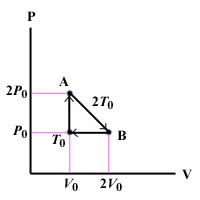
Conceptual Questions:
1. Describe a situation of your own imagination (neither a text nor a lecture example) to which the second law of thermodynamics applies. Be sure your "situation" is isolated from the outside (explain how), and then explain how entropy or order changes within the situation.
2. In an isothermal process for an ideal gas system (where the internal energy doesn't change), which of the following choices best corresponds to the value of the work done by the system?
a. It equals the value of its heat intake.
b. It is twice the value of heat intake.
c. It is the negative of the heat intake.
d. It is twice the negative of the heat intake.
3. Which of the following choices best corresponds to what is required by the second law of thermodynamics for any process taking place in an isolated system?
a. Entropy decreases.
b. Entropy remains constant.
c. Entropy increases.
d. Entropy equals work done.
4. A one kilogram chunk of ice at 0 řC melts, absorbing 80,000 cal of heat in the process. Which of the following best describes what happens to this system?
a. Entropy is gained.
b. Entropy is lost.
c. Entropy is maintained constant.
d. Work is converted to energy.
5. According to the first law of thermodynamics, the difference in heat gained by a system and the work done by that same system is equivalent to which of the following?
a. An entropy change.
b. An internal energy change.
c. A temperature change.
d. The specific heat.
6. In an isovolumetric process by an ideal gas, the system's heat gain is equivalent to a change in:
a. temperature.
b. volume.
c. pressure.
d. internal energy.
7. According to the second law of thermodynamics, which of the following applies to the heat received from a high temperature reservoir by a heat engine operating in a complete cycle?
a. It must be completely converted to work.
b. It equals the entropy increase.
c. It is converted completely into internal energy.
d. It cannot be completely converted to work.
8. An adiabatic free expansion refers to the fact that:
a. no heat is transferred between a system and its surroundings.
b. The pressure remains constant.
c. the temperature remains constant.
d. the volume remains constant.
9. In which system is heat usually transferred from the cooler part to the warmer part?
a. A stove as it heats up water.
b. A refrigerator that is running.
c. An electric fan that is running.
d. None of the above, because it is impossible to transfer heat in this manner.
Numerical Problems: answers link to a help page.
1. The volume of an ideal gas changes from 0.40 to 0.55 m3 although its pressure remains constant at 50,000 N/m2. What work is done by the system on its environment?
2. A 2 kg block of ice is at 1 ATM while it melts completely to water. What is its change in entropy? (For ice, Lf = 3.34 x105 J/kg)
3. An avalanche of ice and snow of mass 1800 kg slides a vertical distance of 160 meters down a mountainside. If the temperature of the ice, snow, mountain and surrounding air are all at 0 řC, what is the change in entropy of the universe?
4. What is the work done by the gas as it expands from pressure
P1 and volume V1 to pressure P2
and volume V2 along the indicated straight line?

5. An ideal gas at pressure, volume, and temperature,
P0, V0, and T0, respectively, is
heated to point A, allowed to expand to point B at constant temperature
2T0, and then returned to the original T0 condition.
The internal energy decreases by 3P0V0/2 going
from point B to point T0.
In going around this cycle once, which quantity equals zero?

a. The total change in internal energy of the gas.
b. The total work done by the gas.
c. The total heat added to the gas.
d. All three are zero.